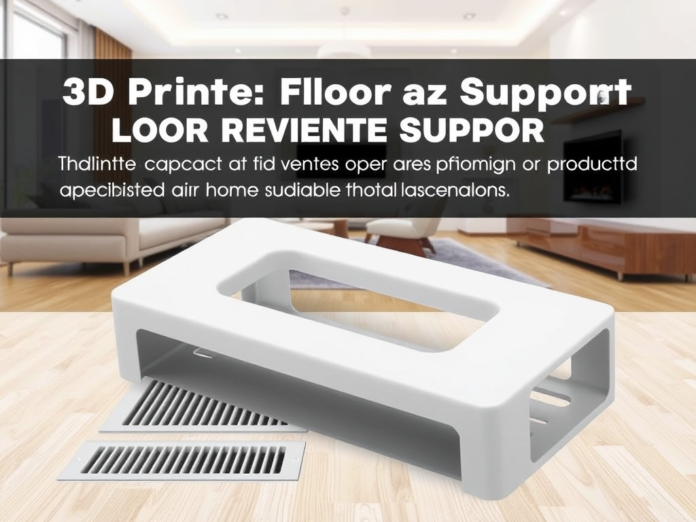Often, little things determine how well your home’s heating and cooling system runs.
One overlooked issue is floor registers that close or shift accidentally. Higher expenses, lost energy, and inconsistent temperatures could result from this. Fortunately, a 3D print to keep the floor register open allows you to design a straightforward, affordable way to preserve constant ventilation in your house. In this article, we’ll explore how to create, print, and install an easy fix for keeping floor registers open, boosting comfort and efficiency without spending a lot of money.

Why 3D Print a Floor Register Support?
A blocked or closed register can seriously affect how well your HVAC system heats or cools your home.
Top reasons to 3D print a floor register holder:
- Better airflow: Ensures that heated or cooled air gets where it’s supposed to go.
- Lower energy bills: Helps your HVAC system work harder, saving you money.
- Custom fit: Create a holder that fits your specific register perfectly.
- Quick and affordable: Prints in a few hours and costs just a few cents in material.
- Reusable and replaceable: Easy to reprint if lost or damaged.
It’s a simple project with significant benefits for your home’s efficiency.
Best Materials for Printing a Register Holder
Choosing the right material ensures durability, especially near warm vents.
Top filament choices:
- PETG: Strong and heat-resistant, perfect for warmer air registers.
- ABS: Great heat resistance but needs careful printing.
- PLA+: Easy to print and strong enough for most indoor use.
- ASA: UV-resistant and heat-stable, ideal for homes with lots of sunlight.
For most users, PETG offers the best balance of heat resistance and printability.
How to Design an Effective Floor Register Support
A practical holder must be sturdy but straightforward.
Important design features:
- Compact size: Small enough to avoid tripping hazards but big enough to hold the vent open.
- Stable base: A broad footprint helps keep the support in place.
- Adjustability: Some designs allow you to adjust for different angles or vent styles.
- Low profile: Keeps the backing out of sight while doing its job.
Even basic L-shaped brackets can work perfectly for many types of floor registers.
Best Printing Settings for a Strong Support
To print a durable holder, use the following settings:
- Layer height: 0.2 mm for a good balance of speed and strength.
- Infill density: 40%-60% for solid strength.
- Wall count: 3 or more for extra durability.
- Supports: Usually not needed unless the design has overhangs.
- Bed temperature: 60°C (for PETG) to prevent warping.
- Print speed: Moderate (50mm/s) for clean, strong layers.
Sturdy prints ensure your support stays reliable over time.
Simple Installation Tips
Installing your 3D printed floor register support is easy:
- Clean the area: Remove any dust or debris around the register.
- Insert it carefully: Slide the support under the vent flap, adjusting it to the right height.
- Test stability: Ensure the support doesn’t shift when the HVAC system turns on.
- Adjust if needed: If it’s too loose or tight, sand slightly or reprint at a somewhat different size.
A few minutes of setup make a big difference in comfort.
Creative Customisation Ideas
While function matters most, a little creativity can make the project even better:
- Colour match: Print the holder in a colour similar to your flooring or vent.
- Decorative shapes: Create supports in the shape of mini columns, cubes, or geometric designs.
- Hidden designs: Create a holder that tucks entirely underneath for an invisible solution.
- Flexible designs: Add rubber pads or clips for a better grip without damaging metal vents.
Customising your project adds a personal touch without much extra effort.
Common Problems and How to Solve Them
Weak Supports
- Problem: Support snaps under vent pressure.
- Solution: Increase infill and wall thickness, and use PETG or ABS filament.
Warping
- Problem: The base of the holder lifts off during printing.
- Solution: Use a heated bed, start with slower first layers, and employ strong bed adhesion methods.
Poor Fit
- Problem: The Holder doesn’t sit securely under the register.
- Solution: Measure carefully before designing or modifying the model slightly in your slicer.
A little careful preparation saves a lot of frustration later.
READ MORE – 3D Print Lightstick Holder: Protect and Display Your Concert Treasures
FAQs:
Q1: What is the best material for printing a floor register holder?
A1: PETG is ideal for its heat resistance and strength.
Q2: Can I use PLA for this project?
A2: Yes, but it might soften slightly near very hot air vents. PLA+ offers a stronger option.
Q3: How long does it take to 3D print a register holder?
A3: Most designs print in 2 to 5 hours, depending on size and infill settings.
Q4: Do I need special tools to install the holder?
A4: No, installation usually just involves sliding it into place — no screws or adhesives needed.
Q5: Can I make adjustable floor register holders?
A5: Absolutely. Hinged or sliding designs can be created for flexible setups.
Conclusion:
A 3D print to keep the floor register open is a brilliant DIY solution that costs little but delivers significant benefits. From better airflow to lower energy bills, creating a custom holder makes your home more comfortable and efficient. With easy-to-find materials, simple designs, and fast print times, anyone with a 3D printer can upgrade their HVAC setup effortlessly. Get started today and enjoy a smarter, better-functioning home with just one clever print!




